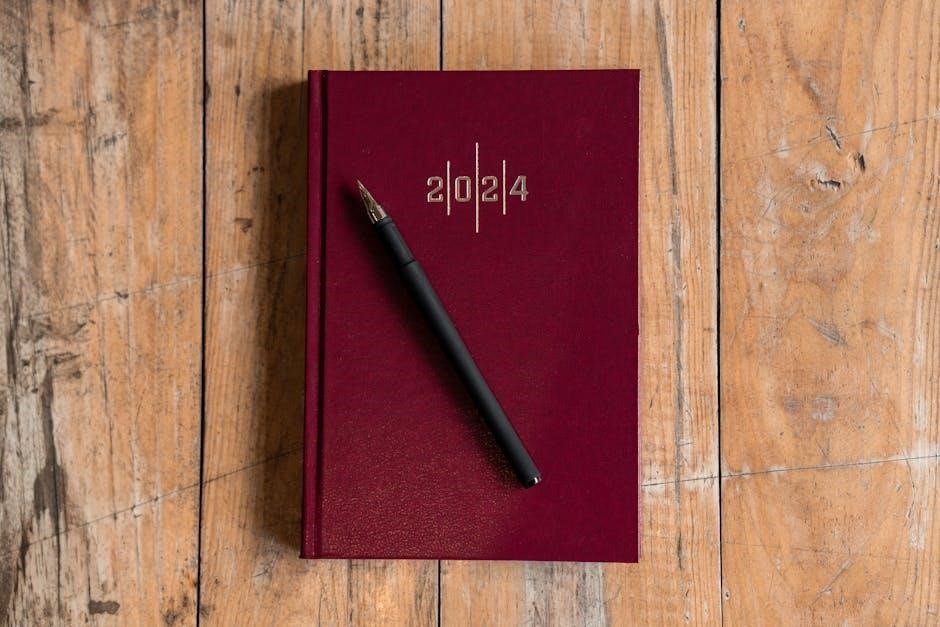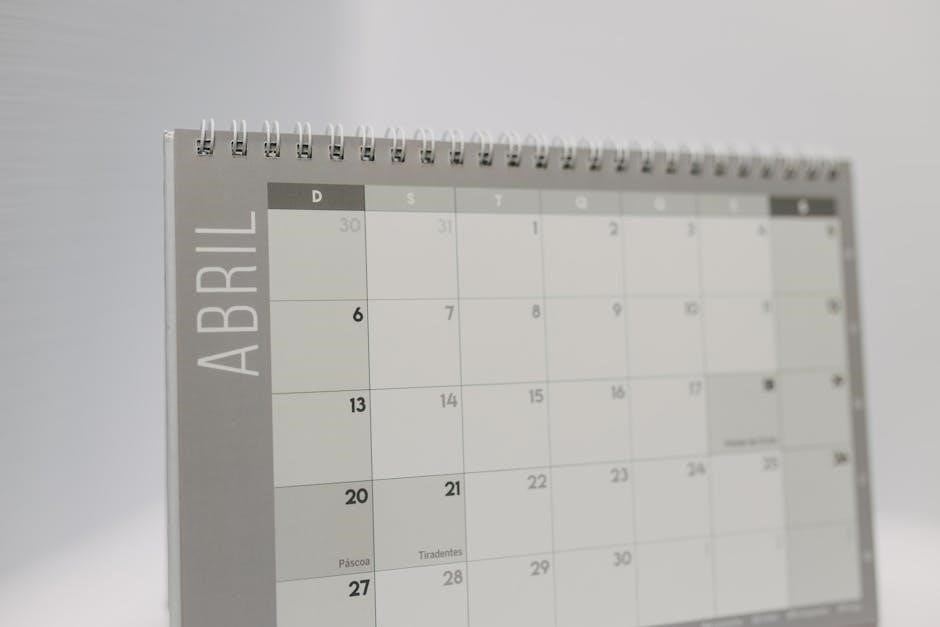The 2023-2024 Jewish Calendar aligns with lunar and solar cycles, detailing holidays like Rosh Hashanah and Yom Kippur, and is available as a downloadable PDF for personal reference.
Overview of the Jewish Calendar System
The Jewish calendar is a lunisolar system, combining lunar months with adjustments to align with the solar year. It consists of 12 or 13 months, beginning with Nisan and ending with Adar. Each month starts with Rosh Chodesh, the new moon. The calendar is essential for determining Jewish holidays, fast days, and Torah readings. The 2023-2024 cycle includes major holidays like Rosh Hashanah, Yom Kippur, Sukkot, and Hanukkah. The PDF format provides a convenient way to track these dates, ensuring accuracy and accessibility for personal or communal use. This system reflects the rich cultural and religious heritage of Judaism, blending tradition with practicality for modern observance.
Structure of the Hebrew Calendar
The Hebrew calendar is a lunisolar system, combining lunar cycles with solar year adjustments. It typically has 12 months, with an additional month (Adar II) added in leap years to synchronize with the solar cycle. Months alternate between 29 and 30 days, beginning with Nisan and ending with Adar. Rosh Chodesh, marking the new moon, is celebrated as the start of each month. The calendar’s structure ensures alignment with both lunar phases and the solar year, maintaining the timing of holidays and observances. PDF versions of the 2023-2024 calendar provide clear layouts, highlighting important dates and ensuring easy reference for users. This system reflects the balance between tradition and practicality, guiding Jewish life throughout the year.
Significance of the 2023-2024 Jewish Calendar
The 2023-2024 Jewish Calendar holds profound cultural and religious significance, serving as a guide for Jewish life and observances. It aligns with both lunar and solar cycles, ensuring the accurate timing of holidays like Rosh Hashanah and Yom Kippur. This calendar is essential for planning spiritual rituals, community events, and personal reflection. Its structure, rooted in tradition, provides a framework for connecting with Jewish heritage and faith. The inclusion of detailed Hebrew dates, holidays, and Torah portions makes it a vital resource for both individuals and communities. Additionally, the availability of downloadable PDF versions enhances accessibility, allowing users to easily reference and share the calendar. This tool not only preserves tradition but also fosters engagement with Jewish practices in a modern, convenient format.

Jewish Holidays and Observances in 2023-2024

The 2023-2024 Jewish Calendar outlines major observances like Rosh Hashanah, Yom Kippur, Sukkot, and Hanukkah, providing Hebrew dates and aligning with lunar phases for accurate holiday timing and traditions.
Major Jewish Holidays in 2023-2024
The 2023-2024 Jewish Calendar highlights major holidays such as Rosh Hashanah (September 2023), a time for reflection and renewal, and Yom Kippur (September 2023), the Day of Atonement. Sukkot (September-October 2023) commemorates the Exodus with outdoor gatherings, while Shmini Atzeret and Simchat Torah (October 2023) celebrate the Torah’s completion. In November 2023, Hanukkah honors the rededication of the Temple. The spring brings Passover (March-April 2024), a week-long observance of liberation from Egypt. These holidays are central to Jewish tradition, offering moments for spirituality, family, and community connection. The PDF calendar provides detailed dates, rituals, and cultural significance, ensuring followers can prepare and participate meaningfully in these sacred observances.
Fast Days and Their Importance
Fasting is a significant aspect of Jewish observance, with several fast days in 2023-2024. The most notable is Tisha B’Av (July 2023), commemorating the destruction of the First and Second Temples. Other fasts include Shivah Asar B’Tammuz (June 2023), marking the breach of Jerusalem’s walls, and Tzom Gedaliah (September 2023), honoring Rabbi Gedaliah’s assassination. Yom Kippur (September 2023) is the holiest fast day, focusing on atonement. These fasts promote reflection, repentance, and unity among Jews. The PDF calendar details each fast’s dates, traditions, and historical context, helping individuals observe these solemn occasions with reverence and understanding. Fasting fosters spiritual growth and strengthens communal bonds, aligning with the calendar’s lunar cycle and religious customs.
Rosh Chodesh and Its Observance
Rosh Chodesh, the celebration of the new moon, is a significant observance in the Jewish calendar, marking the beginning of each Hebrew month. It is a time for renewal and reflection, often accompanied by special prayers and customs. In 2023-2024, the PDF calendar highlights each Rosh Chodesh date, providing details on its traditions and cultural significance. Women traditionally light candles to usher in the new month, while congregations recite Hallel (psalms of praise) in synagogue services. This observance fosters a connection to the lunar cycle and the rhythm of Jewish life. The downloadable PDF format ensures easy access to these dates, enabling individuals to prepare for and engage with Rosh Chodesh meaningfully. This tradition underscores the importance of community and spiritual renewal in Jewish practice.
Weekly Torah Portions and Their Relevance
The 2023-2024 Jewish Calendar includes detailed weekly Torah portions, each aligned with the lunar cycle and Jewish holidays. These portions, read in synagogues worldwide, provide spiritual guidance and cultural connection. Each week, a specific section of the Torah is studied, fostering communal unity and religious observance. The PDF format allows easy access to these readings, enabling individuals to follow along and reflect on the teachings. The cycle begins with Bereshit and concludes with V’Zot HaBrachah, covering the entire Torah in a year. This tradition strengthens Jewish identity and provides a shared educational experience across generations. The calendar’s inclusion of these portions highlights their enduring relevance in Jewish life and practice, making it a valuable resource for personal and communal study.

Key Features of the 2023-2024 Jewish Calendar
The 2023-2024 Jewish Calendar aligns with lunar and solar cycles, includes major holidays like Rosh Hashanah and Yom Kippur, and is available as a downloadable PDF for easy reference.
Alignment with Lunar and Solar Cycles
The 2023-2024 Jewish Calendar is meticulously aligned with both lunar and solar cycles, ensuring accurate observance of holidays and traditions. The Hebrew calendar combines lunar months with adjustments to synchronize with the solar year, preventing drift over time. This system includes 12 or 13 months, depending on whether it is a leap year, to maintain harmony between the cycles. The extra month, known as Adar II, is added to ensure alignment with the solar year. This dual-cycle system is unique and essential for determining the correct dates for Jewish holidays, such as Rosh Hashanah and Passover, which are tied to specific lunar phases and solar seasons.
The calendar begins with the new moon, marking Rosh Chodesh, and major holidays often coincide with significant lunar events, such as the full moon. This alignment is crucial for religious observances and reflects the deep connection between Jewish traditions and celestial rhythms.
Inclusion of Biblical and Talmudic Holidays
The 2023-2024 Jewish Calendar meticulously includes both Biblical and Talmudic holidays, ensuring a comprehensive observance of Jewish traditions. Holidays such as Rosh Hashanah, Yom Kippur, Sukkot, Passover, Shavuot, and Hanukkah are prominently featured, reflecting their deep roots in Jewish scripture and law. These holidays are not only central to Jewish practice but also carry significant cultural and historical importance, as outlined in both the Hebrew Bible and the Talmud.
The calendar also highlights lesser-known observances, such as the Fast of Gedaliah and Tu B’Av, providing a detailed guide for their proper observance. This inclusion ensures that users can fully engage with the rich tapestry of Jewish traditions, whether they are rooted in biblical commandments or developed through Talmudic interpretations. The 2023-2024 Jewish Calendar serves as an essential resource for those seeking to honor these holidays with authenticity and depth.
Downloadable PDF Formats for Convenience
The 2023-2024 Jewish Calendar is readily available in downloadable PDF formats, designed for easy access and convenience. These PDFs are free to download and can be printed on standard 8.5×11 paper, making them ideal for personal use or distribution within communities. The PDF versions include detailed Hebrew dates, holiday descriptions, and important observances, ensuring a comprehensive guide for Jewish traditions. Additionally, customizable templates in Word and Excel formats allow users to tailor the calendar to their specific needs, whether for educational purposes, personal study, or community events. The PDFs are aligned with both lunar and solar cycles, providing accurate holiday timings and ensuring adherence to Jewish law. This feature-rich format makes it a valuable resource for anyone seeking to stay connected with Jewish traditions throughout the year.
Details on Shabbat and Holiday Rituals
The 2023-2024 Jewish Calendar PDF provides detailed insights into Shabbat and holiday rituals, ensuring observance is both meaningful and accurate. It includes candle-lighting times for Shabbat and holidays, Torah reading schedules, and specific customs for each observance. For Rosh Hashanah, the calendar highlights the importance of hearing the shofar, while Yom Kippur details fasting times and prayer services. Sukkot includes instructions for building and dwelling in a sukkah, and Shemini Atzeret/Simchat Torah feature guidelines for Torah dancing and celebrations. The calendar also outlines menorah lighting times for Hanukkah and explains the significance of fasting on Tisha B’Av. These details help individuals and communities adhere to traditions, fostering a deeper connection to Jewish practices throughout the year. The PDF format ensures easy access to these rituals, making it a indispensable guide for observant Jews worldwide.

Downloading and Using the Jewish Calendar PDF
The 2023-2024 Jewish Calendar PDF is easily downloadable in various formats, including Word and Excel, offering Hebrew dates, holidays, and events for convenient planning and reference.
Where to Find the 2023-2024 Jewish Calendar PDF
The 2023-2024 Jewish Calendar PDF can be downloaded from various online sources, including Jewish educational websites, synagogues, and community organizations. Websites like Chabad.org, JewishLifeServices.org, and jewishcincinnati.org offer free downloadable versions. Additionally, platforms like Shabbat.com and HebCal.com provide customizable PDF calendars with Hebrew dates, holidays, and Torah readings. Some organizations, such as the Union for Reform Judaism and Orthodox Union, also distribute downloadable calendars. These PDFs are often available in multiple formats, including Word and Excel, making them easy to print or modify. Ensure to verify the credibility of the source to guarantee accuracy and adherence to your specific Jewish tradition.
How to Print and Customize the Calendar

To print and customize the 2023-2024 Jewish Calendar PDF, download it from trusted sources like Chabad.org or JewishLifeServices.org. Ensure the file is in a printable format, such as PDF, Word, or Excel. For customization, use tools like Adobe Acrobat or Microsoft Word to add personal notes, highlight important dates, or adjust layouts. Print the calendar on standard 8.5×11 paper, ensuring proper orientation for readability. Some versions allow customization of fonts, colors, and content to suit individual preferences. Additionally, many PDFs are designed with editable fields for personalization. For high-quality prints, consider using professional printing services. Always verify the accuracy of the calendar’s details before printing, as variations may exist across communities. This ensures the calendar meets your specific needs and remains a reliable reference throughout the year.
Using the Calendar for Personal Study and Reference
The 2023-2024 Jewish Calendar PDF is an invaluable tool for personal study and reference, offering detailed listings of holidays, Rosh Chodesh dates, and weekly Torah portions. Individuals can use it to track significant events, plan spiritual practices, and deepen their understanding of Jewish traditions. The calendar aligns with both lunar and solar cycles, providing a comprehensive view of the year. For those engaged in Torah study, the inclusion of weekly parashot helps in following the annual reading cycle. Additionally, the calendar’s structure allows users to note important personal dates, creating a blend of tradition and personal milestones. Its portability and digital accessibility make it easy to reference during daily routines, ensuring that one stays connected to Jewish heritage throughout the year. This resource is particularly useful for educators, students, and anyone seeking to enrich their Jewish knowledge and practice.
Integrating the Calendar into Daily Life
Integrating the 2023-2024 Jewish Calendar into daily life enhances spiritual and cultural connection. By aligning personal routines with the calendar’s dates, individuals can observe holidays, Rosh Chodesh, and Shabbat more meaningfully. The PDF format allows easy access on devices, enabling users to set reminders for important events and plan activities around sacred times. Families can use the calendar to teach children about Jewish traditions, fostering a sense of heritage. Professionals may align work schedules with religious obligations, ensuring balance between faith and career. Additionally, the calendar’s portability makes it a handy reference for daily reflection and planning, helping individuals stay connected to their Jewish identity throughout the year. This integration not only enriches personal life but also strengthens community bonds by synchronizing collective observances.

Cultural and Historical Significance
The Jewish Calendar 2023-2024 embodies the cultural fabric of Jewish life, reflecting spiritual heritage and historical continuity through its alignment with lunar and solar cycles, biblical roots, and Talmudic traditions.

History of the Jewish Calendar and Its Evolution
The Jewish calendar traces its origins to ancient times, rooted in biblical traditions and evolving over centuries. Its structure, combining lunar and solar cycles, ensures alignment with both agricultural seasons and spiritual observances. Historically, the calendar was refined during the Babylonian exile and further developed by Jewish sages in Talmudic times. The modern Hebrew calendar, finalized in the 4th century CE, standardizes the 12- or 13-month cycle, incorporating leap years to maintain balance. Today, it serves as a cornerstone of Jewish life, guiding communal worship, personal observance, and cultural identity. Its enduring relevance underscores the interplay between tradition and adaptation, reflecting the enduring spirit of Jewish heritage.
Cultural Events and Traditions in 2023-2024
The 2023-2024 Jewish calendar is rich with cultural events and traditions that reflect the vibrant tapestry of Jewish life. From the High Holy Days of Rosh Hashanah and Yom Kippur to the joyous celebrations of Sukkot, Simchat Torah, and Hanukkah, the year is marked by communal gatherings, traditional meals, and spiritual reflection. Cultural festivals, educational programs, and art exhibitions further enrich the calendar, offering opportunities for learning and connection. These events are complemented by customs such as lighting the Hanukkah menorah, building sukkahs, and participating in seders during Passover. The calendar also highlights minhagim (customary practices) unique to different Jewish communities, ensuring a diverse and inclusive celebration of heritage. Together, these traditions foster a sense of unity and continuity, celebrating the enduring spirit of Jewish culture.
The Role of the Calendar in Jewish Communities
The Jewish calendar plays a vital role in uniting communities by providing a shared framework for spiritual and cultural observance. It serves as a central tool for organizing rituals, holidays, and daily life, ensuring synchronization across diverse Jewish populations. The 2023-2024 calendar, available in PDF formats, is widely used to plan synagogue services, educational programs, and communal events. It fosters a sense of unity and continuity, helping individuals and communities stay connected to their heritage. By outlining key dates and traditions, the calendar acts as a guide for both personal and collective observance, making it an indispensable resource for Jewish life. Its accessibility in digital formats ensures it reaches a broad audience, further strengthening its role in preserving and promoting Jewish traditions.
Minhagim and Customary Practices
Minhagim, or customary practices, are integral to Jewish tradition, varying across communities and regions. The 2023-2024 Jewish Calendar PDF highlights these customs, ensuring their preservation and observance. From Ashkenazi to Sephardic traditions, the calendar details specific rituals, such as Rosh Hashanah’s shofar blowing and Yom Kippur’s fasting. It also includes local customs, like special prayers or meals, unique to certain communities. These practices are often tied to holidays and life-cycle events, serving as a bridge between tradition and modern life. The calendar acts as a guide, helping individuals and families incorporate Minhagim into their daily and festive routines. By documenting these customs, the calendar ensures their continuity, fostering a sense of identity and connection to Jewish heritage. It reflects the diversity of Jewish traditions while maintaining their timeless relevance.

Practical Applications and Resources
The 2023-2024 Jewish Calendar offers practical tools for daily planning, educational insights into customs, and resources for community events, enhancing both personal and collective Jewish observance.
Using the Calendar for Educational Purposes
The 2023-2024 Jewish Calendar is a valuable educational tool, offering detailed Torah portions and aligning with lunar cycles for teaching. Its downloadable PDF format makes it easy for students and educators to track holidays, fast days, and significant events. Schools and educators can use the calendar to plan lessons and ensure observance of Jewish traditions. It also provides a structured framework for teaching about the Hebrew months, Rosh Chodesh, and the cultural significance of each holiday. Additionally, the calendar’s inclusion of historical and biblical context enhances learning about Jewish heritage. For personal study, the PDF format allows individuals to mark important dates and reflect on their spiritual journey. This resource is essential for fostering a deeper understanding of Jewish practices and traditions in both formal and informal educational settings.
Tools for Tracking Jewish Holidays and Events
The 2023-2024 Jewish Calendar offers a variety of tools to help individuals and communities track holidays and events effectively. Downloadable PDF formats provide a clear and organized way to mark important dates, while digital versions allow for easy customization and integration into personal or community schedules. Many tools include features like customizable reminders, historical context, and alignment with lunar cycles for accurate tracking. Additionally, online platforms and apps offer interactive versions of the calendar, enabling users to set notifications for upcoming holidays and fast days. These tools are particularly useful for educators, who can incorporate them into lesson plans, and for individuals seeking to deepen their connection to Jewish traditions. By leveraging these resources, one can stay informed and engaged with the rich tapestry of Jewish observances throughout the year.
Resources for Further Study and Exploration
For those seeking deeper understanding, the 2023-2024 Jewish Calendar offers a wealth of resources for further study and exploration. Downloadable PDF guides provide detailed explanations of holidays, traditions, and historical context, making them ideal for personal or educational use. Websites like jewishcincinnati.org offer comprehensive lists of Jewish holidays and observances, complete with dates and customs. Additionally, educational institutions and Jewish organizations often publish accompanying materials, such as liturgical readings and cultural insights, to enrich one’s connection to the calendar. These resources are particularly valuable for educators, students, and individuals looking to explore the cultural and historical significance of the Jewish calendar in greater depth. They serve as a bridge between tradition and modern practice, fostering a deeper appreciation for Jewish heritage and observance.
Community Events and Gatherings in 2023-2024
The 2023-2024 Jewish Calendar highlights a variety of community events and gatherings that celebrate Jewish heritage and foster connection. From Rosh Hashanah to Yom Kippur, Sukkot, Hanukkah, Passover, and Shavuot, these holidays serve as opportunities for communal observance and joy. Many synagogues and Jewish organizations host special services, meals, and educational programs, while others organize cultural events like festivals, lectures, and workshops. These gatherings not only strengthen community bonds but also provide opportunities for learning and spiritual growth. Additionally, organizations like the Jewish Women’s Circle and Chabad of Valley Stream offer events tailored to women, families, and youth, ensuring inclusive participation. These events are often listed in downloadable PDF calendars, making it easy for individuals to stay informed and engaged in Jewish life throughout the year.
The 2023-2024 Jewish Calendar reflects Jewish traditions, aligning with lunar and solar cycles, guiding spiritual and cultural practices, and fostering unity and faith across generations and communities worldwide.

Reflections on the Importance of the Jewish Calendar
The Jewish Calendar 2023-2024 holds profound significance as a spiritual and cultural guide, connecting individuals to their heritage through its alignment with lunar and solar cycles. It serves as a cornerstone for Jewish life, outlining holidays, fast days, and Torah readings that foster communal unity and personal reflection. By adhering to its structure, Jews worldwide maintain traditions and practices passed down through generations. The calendar’s inclusion of Rosh Chodesh, Shabbat rituals, and festivals like Rosh Hashanah and Yom Kippur emphasizes its role in preserving Jewish identity. Its availability in downloadable PDF formats ensures accessibility for modern users, blending tradition with convenience. Ultimately, the Jewish Calendar 2023-2024 is not just a timekeeping tool but a vital link to faith, history, and community, enriching both individual and collective Jewish experiences.
Looking Ahead to Future Calendars and Observances
As the 2023-2024 Jewish Calendar concludes, future calendars will continue to align with lunar and solar cycles, ensuring accurate holiday dates and Torah readings. The downloadable PDF formats will remain a popular choice, offering convenience and accessibility. Upcoming calendars will highlight key observances like Rosh Hashanah, Yom Kippur, and Sukkot, preserving traditions while adapting to modern needs. They will also include Shabbat rituals, Rosh Chodesh, and fast days, maintaining the spiritual rhythm of Jewish life. By integrating cultural and educational resources, future calendars will serve as essential tools for personal study and communal gatherings, fostering a deeper connection to Jewish heritage. Their evolution will reflect the dynamic nature of Jewish traditions, ensuring relevance for generations to come.
Final Thoughts on the 2023-2024 Jewish Calendar
The 2023-2024 Jewish Calendar serves as a vital bridge between tradition and modern life, offering a comprehensive guide to Jewish holidays, observances, and cultural practices. By aligning with lunar and solar cycles, it ensures accuracy and continuity, preserving the rich heritage of Jewish traditions. The inclusion of major holidays like Rosh Hashanah, Yom Kippur, and Sukkot, alongside weekly Torah portions, provides a spiritual framework for the year. Its availability in downloadable PDF formats makes it accessible for personal study and communal use, fostering a deeper connection to Jewish identity. As a practical and symbolic tool, the 2023-2024 Jewish Calendar not only honors the past but also guides the present, ensuring that Jewish traditions thrive for future generations.
